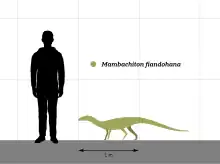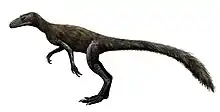| Mambachiton Temporal range: Middle/Late Triassic, | |
|---|---|
| Scientific classification | |
| Domain: | Eukaryota |
| Kingdom: | Animalia |
| Phylum: | Chordata |
| Clade: | Sauropsida |
| Clade: | Archosauria |
| Clade: | Avemetatarsalia |
| Genus: | †Mambachiton Nesbitt et al., 2023 |
| Species: | †M. fiandohana |
| Binomial name | |
| †Mambachiton fiandohana Nesbitt et al., 2023 | |
Mambachiton (meaning "crocodile armour") is an extinct genus of basal avemetatarsalian from the Middle/Upper Triassic Makay Formation (Isalo II beds) of Madagascar. The genus contains a single species, M. fiandohana, known from a partial skeleton with articulated osteoderms.[1]
Discovery and naming
The Mambachiton fossil specimens were discovered in sediments of the Makay Formation near Sakaraha in the southern Morondava Basin of Madagascar, and excavated later in 1997, 1998, and 2003. The holotype specimen, UA 8-25-97-132, consists of an articulated series of cervical vertebrae with associated osteoderms, a cervical rib, and a nearly-complete right postfrontal. An additional referred specimen, FMNH PR 5065, was found near the holotype and includes dorsal, sacral, and caudal vertebrae, both scapulocoracoids, the right ilium, and a partial femur.[1]
The specimen was mentioned in a 2019 abstract.[2] In 2023, Nesbitt et al. described Mambachiton fiandohana as a new genus and species of avemetatarsalian archosaurs based on these fossil remains. The generic name, "Mambachiton", combines the Swahili word "mamba", meaning "crocodile" with the Ancient Greek "khiton" ("χιτών"), meaning "a suit of armour". The name also references chiton molluscs, as the armour of Mambachiton superficially resembles that of polyplacophorans. The specific name, "fiandohana", is derived from a Malagasy word meaning "source" or "beginning", as Mambachiton is phylogenetically close to the crocodile-bird split.[1]
Description

Mambachiton was a similar size to the Tanzanian aphanosaur Teleocrater, which was about 7–10 feet (2.1–3.0 m) in body length.[3] Osteoderms were found articulated with the fossilized vertebrae of Mambachiton, including three pairs of osteoderms above each cervical vertebra.[1]
Classification

Nesbitt et al. (2023) recovered Mambachiton as the earliest diverging member of Avemetatarsalia. They specifically noted that it lacks multiple characters of the minimally inclusive clade containing aphanosaurs and ornithodirans, and is thus nested outside of that clade. Preliminary analyses considered Mambachiton to be a basal poposauroid (a clade of pseudosuchians), though the later recognition of aphanosaurs as early-diverging avemetatarsalians corrected this view. The results of the phylogenetic analyses of Nesbit et al. (2023) are shown in the cladogram below:[1]
| Archosauria |
| ||||||||||||||||||||||||||||||||||||||||||
Paleoenvironment
Mambachiton was discovered in layers of Isalo II, also referred to as the Makay Formation, which dates to the Middle/Late Triassic period (Ladinian–Carnian ages), though the exact numerical age is currently unknown. The traversodontids Menadon and Dadadon, the rhynchosaur Isalorhynchus, and the lagerpetid Kongonaphon have also been described from the type locality, as well as the remains of unnamed reptiles, synapsids, and possibly amphibians.[1][4][5]
References
- 1 2 3 4 5 6 Nesbitt, Sterling J.; Patellos, Emily; Kammerer, Christian F.; Ranivoharimanana, Lovasoa; Wyss, Andre´ R.; Flynn, John J. (2023-07-25). "The earliest-diverging avemetatarsalian: a new osteoderm-bearing taxon from the Triassic (?Earliest Late Triassic) of Madagascar and the composition of avemetatarsalian assemblages prior to the radiation of dinosaurs". Zoological Journal of the Linnean Society: 1–27. doi:10.1093/zoolinnean/zlad038. ISSN 0024-4082.
- ↑ Patellos, Emily A.; Nesbitt, Sterling J.; Kammerer, Christian F.; Wyss, Andre; Flynn, John J.; Ranivoharimanana, Lovasoa (October 2019). "A new reptile from the ?Middle Triassic of Madagascar may represent the earliest-diverging Avemetatarsalia (Archosauria)". Society of Vertebrate Paleontology Abstracts of Papers, 79th Annual Meeting: 167. Archived from the original on 2020-12-15. Retrieved 2020-06-27.
- ↑ "Discovery of early, 'croc-like' reptile sheds new light on evolution of dinosaurs". University of Birmingham. 2017.
- ↑ Nesbitt, S. J.; Flynn, J. J.; Pritchard, A. C.; Parrish, M. J.; Ranivoharimanana, L.; Wyss, A. R. (2015). "Postcranial osteology of Azendohsaurus madagaskarensis (?Middle to Upper Triassic, Isalo Group, Madagascar) and its systematic position among stem archosaur reptiles". Bulletin of the American Museum of Natural History. 398: 1–126. doi:10.1206/amnb-899-00-1-126.1. hdl:2246/6624. ISSN 0003-0090. S2CID 86289421.
- ↑ Fortuny, Josep; Arbez, Thomas; Mujal, Eudald; Steyer, J. Sébastien (2019-01-02). "Reappraisal of 'Metoposaurus hoffmani' Dutuit, 1978, and description of new temnospondyl specimens from the Middle–Late Triassic of Madagascar (Morondava Basin)". Journal of Vertebrate Paleontology. 39 (1): e1576701. doi:10.1080/02724634.2019.1576701. ISSN 0272-4634. S2CID 146075668.


